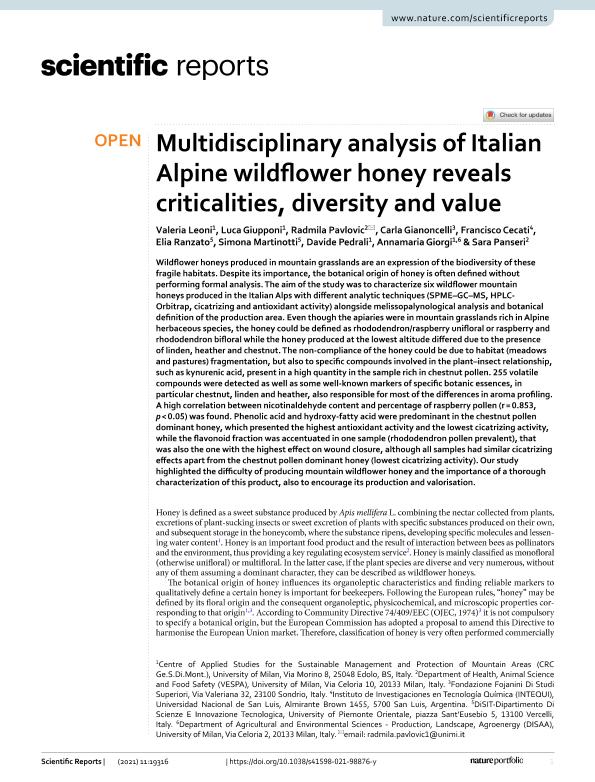Mostrar el registro sencillo del ítem
dc.contributor.author
Leoni, Valeria
dc.contributor.author
Giupponi, Luca
dc.contributor.author
Pavlovic, Radmila
dc.contributor.author
Gianoncelli, Carla
dc.contributor.author
Cecati, Francisco Miguel

dc.contributor.author
Ranzato, Elia
dc.contributor.author
Martinotti, Simona
dc.contributor.author
Pedrali, Davide
dc.contributor.author
Giorgi, Annamaria
dc.contributor.author
Panseri, Sara

dc.date.available
2022-10-04T12:27:27Z
dc.date.issued
2021-09
dc.identifier.citation
Leoni, Valeria; Giupponi, Luca; Pavlovic, Radmila; Gianoncelli, Carla; Cecati, Francisco Miguel; et al.; Multidisciplinary analysis of Italian Alpine wildflower honey reveals criticalities, diversity and value; Nature; Scientific Reports; 11; 1; 9-2021; 1-16
dc.identifier.issn
2045-2322
dc.identifier.uri
http://hdl.handle.net/11336/171653
dc.description.abstract
Wildflower honeys produced in mountain grasslands are an expression of the biodiversity of these fragile habitats. Despite its importance, the botanical origin of honey is often defined without performing formal analysis. The aim of the study was to characterize six wildflower mountain honeys produced in the Italian Alps with different analytic techniques (SPME–GC–MS, HPLC-Orbitrap, cicatrizing and antioxidant activity) alongside melissopalynological analysis and botanical definition of the production area. Even though the apiaries were in mountain grasslands rich in Alpine herbaceous species, the honey could be defined as rhododendron/raspberry unifloral or raspberry and rhododendron bifloral while the honey produced at the lowest altitude differed due to the presence of linden, heather and chestnut. The non-compliance of the honey could be due to habitat (meadows and pastures) fragmentation, but also to specific compounds involved in the plant–insect relationship, such as kynurenic acid, present in a high quantity in the sample rich in chestnut pollen. 255 volatile compounds were detected as well as some well-known markers of specific botanic essences, in particular chestnut, linden and heather, also responsible for most of the differences in aroma profiling. A high correlation between nicotinaldehyde content and percentage of raspberry pollen (r = 0.853, p < 0.05) was found. Phenolic acid and hydroxy-fatty acid were predominant in the chestnut pollen dominant honey, which presented the highest antioxidant activity and the lowest cicatrizing activity, while the flavonoid fraction was accentuated in one sample (rhododendron pollen prevalent), that was also the one with the highest effect on wound closure, although all samples had similar cicatrizing effects apart from the chestnut pollen dominant honey (lowest cicatrizing activity). Our study highlighted the difficulty of producing mountain wildflower honey and the importance of a thorough characterization of this product, also to encourage its production and valorisation.
dc.format
application/pdf
dc.language.iso
eng
dc.publisher
Nature

dc.rights
info:eu-repo/semantics/openAccess
dc.rights.uri
https://creativecommons.org/licenses/by/2.5/ar/
dc.subject
honey
dc.subject
criticalities
dc.subject
Multidisciplinary analysis
dc.subject.classification
Química Orgánica

dc.subject.classification
Ciencias Químicas

dc.subject.classification
CIENCIAS NATURALES Y EXACTAS

dc.title
Multidisciplinary analysis of Italian Alpine wildflower honey reveals criticalities, diversity and value
dc.type
info:eu-repo/semantics/article
dc.type
info:ar-repo/semantics/artículo
dc.type
info:eu-repo/semantics/publishedVersion
dc.date.updated
2022-03-08T21:06:38Z
dc.journal.volume
11
dc.journal.number
1
dc.journal.pagination
1-16
dc.journal.pais
Reino Unido

dc.description.fil
Fil: Leoni, Valeria. Università degli Studi di Milano; Italia
dc.description.fil
Fil: Giupponi, Luca. Università degli Studi di Milano; Italia
dc.description.fil
Fil: Pavlovic, Radmila. Università degli Studi di Milano; Italia
dc.description.fil
Fil: Gianoncelli, Carla. Università degli Studi di Milano; Italia
dc.description.fil
Fil: Cecati, Francisco Miguel. Consejo Nacional de Investigaciones Científicas y Técnicas. Centro Científico Tecnológico Conicet - San Luis. Instituto de Investigaciones en Tecnología Química. Universidad Nacional de San Luis. Facultad de Química, Bioquímica y Farmacia. Instituto de Investigaciones en Tecnología Química; Argentina
dc.description.fil
Fil: Ranzato, Elia. Università degli Studi di Milano; Italia
dc.description.fil
Fil: Martinotti, Simona. Università degli Studi di Milano; Italia
dc.description.fil
Fil: Pedrali, Davide. Università degli Studi di Milano; Italia
dc.description.fil
Fil: Giorgi, Annamaria. Università degli Studi di Milano; Italia
dc.description.fil
Fil: Panseri, Sara. Università degli Studi di Milano; Italia
dc.journal.title
Scientific Reports
dc.relation.alternativeid
info:eu-repo/semantics/altIdentifier/url/https://www.nature.com/articles/s41598-021-98876-y
dc.relation.alternativeid
info:eu-repo/semantics/altIdentifier/doi/http://dx.doi.org/10.1038/s41598-021-98876-y
Archivos asociados
